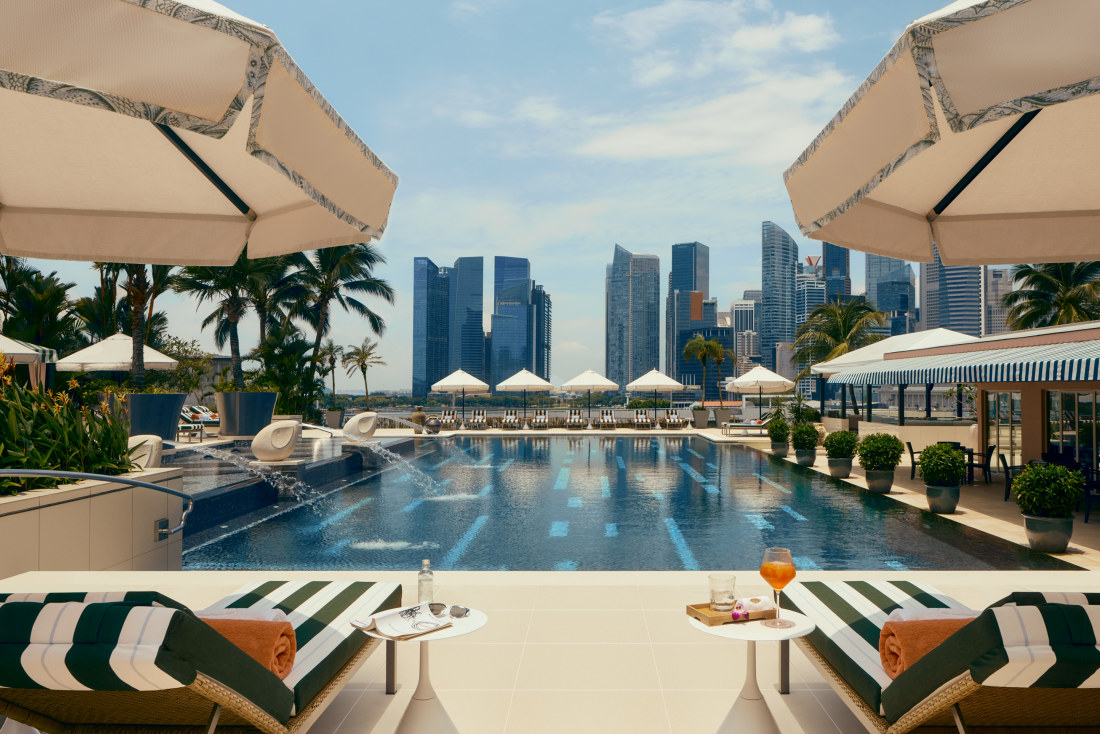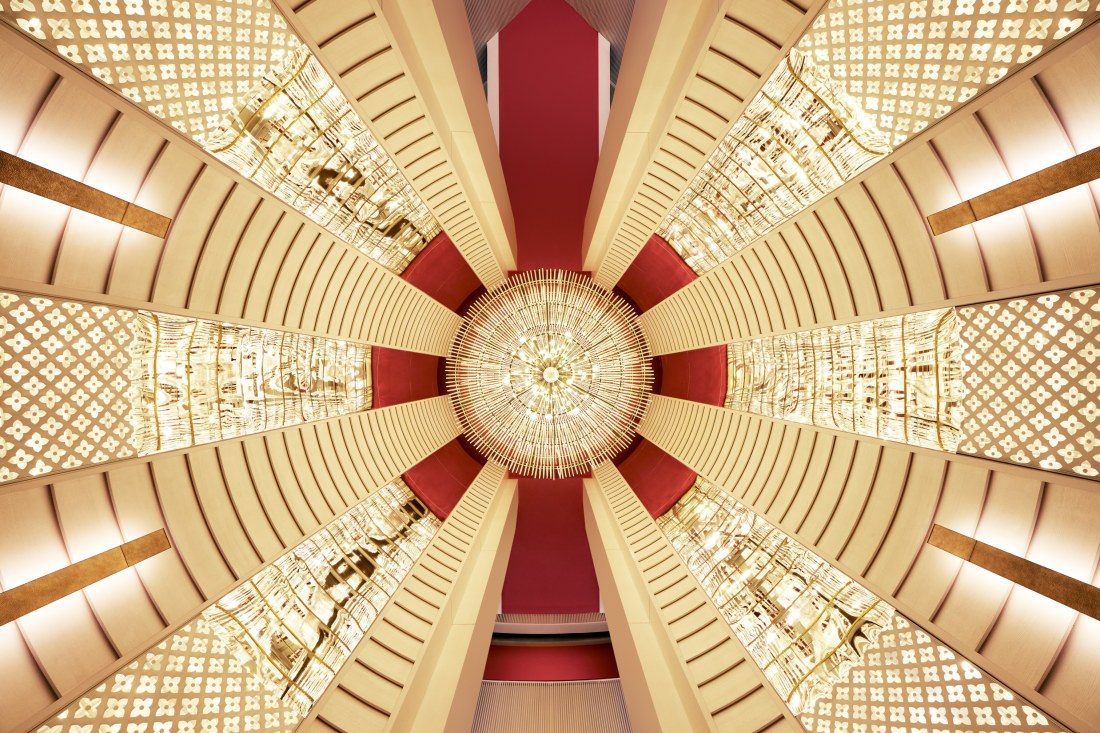The best $150m the Mandarin Oriental Singapore ever spent
A Moët & Chandon vending machine, a cake shop in the lobby and views over Marina Sands are the cherries on top of the hotel’s sparkling $150 million refresh.
The refurbishment of the Mandarin Oriental Singapore is about much more than a new colour scheme or a re-themed restaurant. It tells us about the evolution of the city-state itself.
When the hotel originally opened as The Oriental Singapore in 1987, it had a waterside location, but there wasn’t much to see. Marina Bay did not yet exist, just the dredged sand upon which it would later be built, so the Oriental’s classic fan-shaped footprint was arranged with the best rooms facing the city, not the sea.

The swimming pool and poolside restaurant area, new and improved.
Today, Marina Bay is Singapore’s calling card, a world-famous synthesis of water and dynamic modern architecture, given still greater recognition by the Formula 1 route that snakes right in front of the hotel. This, clearly, is where the best rooms should face.
So when the hotel set about a $US100 million ($150 million) six-month refurbishment earlier this year, it attempted something very bold: to reorient the whole hotel.
“The prime view when Mandarin Oriental Singapore was built 36 years ago was the city landscape, which our suites originally faced,” says general manager Philipp Knuepfer. “With the progressive development of Singapore, the city landscape has flourished with the addition of Marina Bay. So, with our recent transformation, we relocated our suites.”

The bright and airy lighting in the refurbished lobby.
That was easier said than done. First, walls were knocked out between some of the bay-facing rooms, which were turned into suites. The old suites, now with a less inspiring view of exhibition centres and office towers, were converted to long-stay serviced accommodation. Today, the best rooms face the water.
That’s not all that changed. The renovation was led by Jeffrey Wilkes, prinicpal of interior design firm Designwilkes, which is also responsible for the Mandarin Oriental Bangkok’s design. The first thing you notice when you go into the lobby now, and into the soaring internal atrium designed by American architect John Portman, is that it is so much brighter than before.
For some reason, many top hotels developed a fixation with deep brown colours about 20 years ago, and the Mandarin was one of them. No longer: today the colour palette is altogether lighter, with a graded range of pinkish clays – “fifty shades of clay”, Wilkes likes to joke – rising through the atrium, inspired by the colours of roof tiles along the Singapore River.
Gardens and greenery pervade, whether real – the hotel curates its own beautiful orchids with a dedicated in-house team – or in artwork. A vast carpet depicting hundreds of lilies coats the floor of the atrium, and is visible from the internal balconies and lifts.

The best rooms now face Marina Bay rather than city buildings.
The light and colour is not only refreshing, it makes the whole place seem bigger, and this applies to the rooms too. The bay-facing suites really are bigger, twice the size because of the elimination of interior walls, a process that reduced the number of rooms in the hotel from 527 to 510.
The interior design corresponds with the view: water-facing rooms feature light blue pillows and furnishings.

It’s hard to walk past the hotel’s cake shop in the lobby.
My wife and I arrived to check out the new suites at the end of October, just weeks after the hotel reopened: Life & Leisure was the first publication invited to review. We’ve lived in Singapore for more than 14 years over two stints going back to 2006 and have been visiting since the ’90s, so we’ve seen Marina Bay rise and flourish; we’ve also seen the Suntec part of town, where the Mandarin Oriental resides, rise and fall before being lifted again by the bay development and Formula 1.
So we are intrigued to see how the hotel feels in light of this evolution. Along with the Ritz-Carlton next door, it used to be the places to stay for business travellers. But new competitors like The Fullerton Bay Hotel and The Westin have entered the fray, while Raffles, too, has been thoroughly revamped.

The lavish bathroom in a bright and airy Marina Bay king room.
When we stayed in the Mandarin for a staycation in 2021, it was pleasant but felt dated (and brown), lacking a sense of place. How would it feel now? Would it seem relevant, magnetic once more?
The short answer is yes. There’s no doubting we are in Singapore: the glass doors at the entrance remind you of the classic Peranakan shophouse fronts one still sees in the city; the terrazzo flooring in the lobby evokes those found in many south-east Asian homes.
A new cake shop in the lobby sells local delicacies, also made on site. A Moët & Chandon vending machine on the fifth floor is harder to place culturally, but adds a sense of fun.

The bedroom overlooks Marina Bay.
The “home-team” theme is most evident in the bars and restaurants. Only one restaurant is wholly new: Melt, a common haunt for business breakfast meetings for many years, has been replaced by embu, whose name is drawn from the middle letters of the tembusu tree, a local evergreen. Greenery is everywhere now, while canopy structures between the tables recall the nearby Supertree Grove on Marina Bay.
The Mandarin’s bar, MO, has kept its name but changed both its appearance and its outlook. Now much more blue than brown, with the original art deco features preserved in its ceiling and bar, it’s the drinks selection that evokes a Singaporean ambience.

The MO Bar has a distinctly Singaporean atmosphere.
MO bar manager Charlie Kim says the bar “features a brand-new menu of cocktails infused with a local twist”. So Iced Lemon Tea is actually a spin on a gin and tonic, with the gin infused with the hotel’s own brand of tea and home-made limoncello. The Reclaimed Sling distills the famous Singapore Sling and serves it as a lollipop garnish to a martini-styled cocktail.
And for the first time, the hotel has linked with the Mandala Club, a private members club housed in a 1928 building in Chinatown. It was formerly the New Majestic Hotel, but recent visitors to Singapore are more likely to remember it as the Straits Clan club (it changed hands in 2021).

The verdant interior of embu, a new restaurant with an emphasis on seafood, Asian and Indian food.
Inspired by a chance encounter between Philipp Knuepfer and Ben Jones, founder and chief executive of Mandala Group, Mandala members get access to the Mandarin’s 21st-floor Haus 65 lounge, while hotel guests with lounge access (166 suites and Marina Bay View rooms fit the bill, or about one-third of guest rooms) can visit the Mandala Club.
The deal offers more than mutual access; the idea here is for co-curation. Mandala Club’s wine program will be available at Haus 65, and various Mandala cultural events will be held there. As for Mandarin Oriental guests, they get something quite different to the usual hotel experience: Mandala Club is the most atmospheric of Singapore’s private members clubs, full of nooks and crannies that lend themselves to quirky ideas.

An airy table setting at embu.
For example, when I visit, one room has become an elegant 12-guest Japanese restaurant set around a U-shaped counter, while another has a ceiling filled to the last square inch with disco balls.
The refurbishment has done much more than refresh the hotel – it has given it a sense of vitality, space and local flavour that warrants a fresh visit. It is not cheap (nothing in Singapore is, these days) but the Mandarin Oriental earns its place at the top tier of Marina Bay’s competitive range of hotels.
The writer was a guest of Mandarin Oriental, Singapore.
Need to know
- Mandarin Oriental, Singapore | 5 Raffles Ave, Singapore. Rooms and suites from 33 sq m to the 393 sq m Royal Marina Bay Penthouse; the new Marina Bay Suites are 62 sq m.
- Rates | From S$750 ($842) a night plus taxes for a Deluxe Room; Seaview Suites from S$1550, Marina Bay View Suites S$2200.
- Dine | Morton’s, The Steakhouse, is an institution. The re-designed Cherry Garden offers excellent Cantonese food. And the new embu has a diverse all-day buffet – the seafood is especially recommended. There’s also a poolside restaurant.
- To book | Call +65 6338 0066, or email mosin-reservations@mohg.com
Introducing your Newsfeed
Follow the topics, people and companies that matter to you.
Find out moreRead More
Latest In Travel
Fetching latest articles